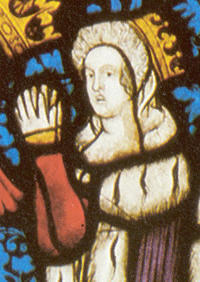Elisabeth van Bohemen (1358-1373)
Elisabeth van Bohemen | ||
1358-1373 | ||
 | ||
Hertogin-gemalin van Oostenrijk Samen met Viridis Visconti (1366-1373) | ||
| Periode | 1366-1373 | |
| Voorganger | Viridis Visconti | |
| Opvolger | Viridis Visconti en Beatrix van Hohenzollern | |
| Vader | Keizer Karel IV | |
| Moeder | Anna van Schweidnitz | |
Elisabeth van Bohemen (Praag, 19 maart 1358 - Wenen, 4 of 19 september 1373) was van 1366 tot aan haar dood hertogin-gemalin van Oostenrijk. Ze behoorde tot het huis Luxemburg.
Levensloop
Elisabeth was de dochter van Karel IV, koning van Bohemen en keizer van het Heilige Roomse Rijk, en diens derde echtgenote Anna van Schweidnitz, dochter van hertog Hendrik II van Schweidnitz.
In 1363 of 1364 werd de vijfjarige Elisabeth verloofd met keurvorst Otto V van Brandenburg. De verloving werd in 1366 ontbonden toen Elisabeth verloofd met hertog Albrecht III van Oostenrijk, terwijl haar oudere halfzus Catharina, de weduwe van Albrechts broer Rudolf IV, met Otto werd verloofd. Op 19 maart 1366 vond het dubbelhuwelijk van de twee zussen plaats in Praag. Hierdoor kwam er een Boheems-Oostenrijkse alliantie, die onder andere het Habsburgse bezit van het graafschap Tirol bevestigde.
In september 1373 stierf Elisabeth op 15-jarige leeftijd. Wegens haar jonge leeftijd was haar huwelijk kinderloos gebleven. Ze werd bijgezet in de kerk van het kartuizersklooster in Gaming.
Bronnen, noten en/of referenties
|